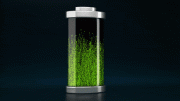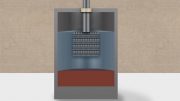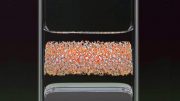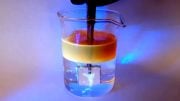
A type of battery first invented nearly five decades ago could catapult to the forefront of energy storage technologies, thanks to a new finding by researchers at MIT and other institutions. Illustration modified from an original image by Felice Frankel
A type of battery first invented nearly five decades ago could catapult to the forefront of energy storage technologies, thanks to a new finding by researchers at MIT and other institutions. The battery, based on electrodes made of sodium and nickel chloride and using a new type of metal mesh membrane, could be used for grid-scale installations to make intermittent power sources such as wind and solar capable of delivering reliable baseload electricity.
The findings are being reported today in the journal Nature Energy, by a team led by MIT professor Donald Sadoway, postdocs Huayi Yin and Brice Chung, and four others.
Although the basic battery chemistry the team used, based on a liquid sodium electrode material, was first described in 1968, the concept never caught on as a practical approach because of one significant drawback: It required the use of a thin membrane to separate its molten components, and the only known material with the needed properties for that membrane was a brittle and fragile ceramic. These paper-thin membranes made the batteries too easily damaged in real-world operating conditions, so apart from a few specialized industrial applications, the system has never been widely implemented.
But Sadoway and his team took a different approach, realizing that the functions of that membrane could instead be performed by a specially coated metal mesh, a much stronger and more flexible material that could stand up to the rigors of use in industrial-scale storage systems.
“I consider this a breakthrough,” Sadoway says, because for the first time in five decades, this type of battery — whose advantages include cheap, abundant raw materials, very safe operational characteristics, and an ability to go through many charge-discharge cycles without degradation — could finally become practical.
While some companies have continued to make liquid-sodium batteries for specialized uses, “the cost was kept high because of the fragility of the ceramic membranes,” says Sadoway, the John F. Elliott Professor of Materials Chemistry. “Nobody’s really been able to make that process work,” including GE, which spent nearly 10 years working on the technology before abandoning the project.
As Sadoway and his team explored various options for the different components in a molten-metal-based battery, they were surprised by the results of one of their tests using lead compounds. “We opened the cell and found droplets” inside the test chamber, which “would have to have been droplets of molten lead,” he says. But instead of acting as a membrane, as expected, the compound material “was acting as an electrode,” actively taking part in the battery’s electrochemical reaction.
“That really opened our eyes to a completely different technology,” he says. The membrane had performed its role — selectively allowing certain molecules to pass through while blocking others — in an entirely different way, using its electrical properties rather than the typical mechanical sorting based on the sizes of pores in the material.
In the end, after experimenting with various compounds, the team found that an ordinary steel mesh coated with a solution of titanium nitride could perform all the functions of the previously used ceramic membranes, but without the brittleness and fragility. The results could make possible a whole family of inexpensive and durable materials practical for large-scale rechargeable batteries.
The use of the new type of membrane can be applied to a wide variety of molten-electrode battery chemistries, he says, and opens up new avenues for battery design. “The fact that you can build a sodium-sulfur type of battery, or a sodium/nickel-chloride type of battery, without resorting to the use of fragile, brittle ceramic — that changes everything,” he says.
The work could lead to inexpensive batteries large enough to make intermittent, renewable power sources practical for grid-scale storage, and the same underlying technology could have other applications as well, such as for some kinds of metal production, Sadoway says.
Sadoway cautions that such batteries would not be suitable for some major uses, such as cars or phones. Their strong point is in large, fixed installations where cost is paramount, but size and weight are not, such as utility-scale load leveling. In those applications, inexpensive battery technology could potentially enable a much greater percentage of intermittent renewable energy sources to take the place of baseload, always-available power sources, which are now dominated by fossil fuels.
The research team also included Fei Chen at Wuhan University in China, MIT research scientist Takanari Ouchi, and postdocs Ji Zhao and Nobuyuki Tanaka. The work was supported by the French oil company Total S.A.
Reference: “Faradaically selective membrane for liquid metal displacement batteries” by Huayi Yin, Brice Chung, Fei Chen, Takanari Ouchi, Ji Zhao, Nobuyuki Tanaka & Donald R. Sadoway, 22 January 2018, Nature Energy.
DOI: 10.1038/s41560-017-0072-1









Is it recyclabe and how many cycles can it be charged before dissipating?